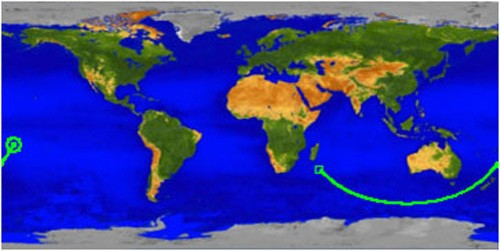NASA Locates Fallen UARS in the Pacific Ocean, Far from Land [MAP]

NASA on Tuesday announced that it has located the Upper Atmosphere Research Satellite (UARS) that crashed down to Earth last week.
They say the defunct satellite is way out into the southern Pacific Ocean, far away from land. The UARS made a fiery re-entry into the Earth's shortly after midnight on Saturday.
Officials with the Joint Space Operations Center at Vandenberg Air Force Base in California have said the satellite fell into the Pacific Ocean 14.1 degrees south latitude and 189.8 degrees east longitude (170.2 west longitude).
This location is over a broad, remote ocean area in the Southern Hemisphere, far from any major land mass, NASA said in a press statement. The debris field is located between 300 miles and 800 miles downrange, or generally northeast of the re-entry point. NASA is not aware of any possible debris sightings from this geographic area.
The space agency has provided a map of the satellite's journey. On the left of it is a green circle pinpointing where the satellite's remains likely landed.
NASA launched the 6.5 ton satellite in 1991 by the Shuttle Discovery. The launch was to enable scientist to better understand the Earth's atmosphere. The satellite was decommissioned in Dec. 14, 2005.
Previously, NASA said 26 UARS components that weighed a total of 1,200 pounds could have survived the fall and landed on the surface of the Earth.
NASA believes that the UARS passed from the east coast of Africa over the Indian Ocean, then the Pacific Ocean, then across northern Canada, and across the northern Atlantic Ocean, before passing over a part of West Africa.
The vast majority of the orbital transit was over water, with some flight over northern Canada and West Africa, NASA said.
Now the space agency said the new calculations show that the 20-year-old satellite entered Earth's atmosphere mostly above American Samoa, according to The Washington Post.
As the falling debris broke apart, they didn't start hitting the water for another 300 miles to the northeast, southwest of Christmas Island, just after midnight EDT on Saturday, the Post also reported.
Experts have said the some two dozen metal pieces from the satellite fell over a 500-mile span.
It's a relatively uninhabited portion of the world, very remote, NASA orbital debris scientist Mark Matney told The Post. This is certainly a good spot in terms of risk.
© Copyright IBTimes 2025. All rights reserved.






















